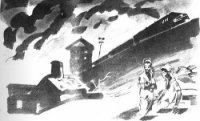Operation Nemesis: The Assassination Plot that Avenged the Armenian Genocide - Bogosian Eric (мир книг .txt) 📗
There is no doubt that many Germans were familiar with what had occurred in Asia Minor. It is probable that hundreds of German soldiers who served in the Ottoman Empire during World War I went on to become Schutzstaffel or “SS” officers in Nazi Germany. In fact, Germany had set a precedent for deportation massacre earlier in the century in German South-West Africa (Namibia), where General Lothar von Trotha successfully pursued an eradication of the Herero by forcing the defenseless indigenous people into the desert, where they died. In addition, one of Hitler’s closest friends, Max von Scheubner-Richter, had been a German officer in Turkey during World War I. He had also served as vice consul in Erzurum, placing him in the center of the action. Scheubner-Richter witnessed and later wrote about the attacks against the Armenians.7 In fact, he was subpoenaed to appear at Tehlirian’s trial but was not called to testify. If Hitler somehow missed the news of Tehlirian’s trial in Berlin, certainly Scheubner-Richter, as a veteran who served in Ottoman territories, must have discussed the war with him. How close was Max von Scheubner-Richter to Adolf Hitler? Scheubner-Richter would be shot and killed, his arm linked through Hitler’s, on the night of the 1923 Beer Hall Putsch.8
As National Socialism found its footing in Germany, the Committee of Union and Progress in Turkey, the Ittihad, stood as an example of what could and could not be accomplished within a modern “constitutional” government. An autocratic and clandestine political faction, the CUP had muscled its way into power. While stoking the furnaces of nationalism, this secretive cabal had arrested its detractors and murdered its foes. Having gained control of the government, these Young Turks liquidated a large and successful minority group and stole their assets. Adolph Hitler has been quoted as declaring, “Who remembers the Armenians?”9 He was saying that there would be no significant reaction to an attack on Jewry in Europe because there had been no real punitive consequences following the destruction of the Armenians.
There are many parallels between the modus operandi of the Nazis and that of the Ittihad. First of all, though the CUP and the Nazis were supposedly political parties, both were born as underground organizations, and by the time they had consolidated their power, both “parties” were illegal by any definition of the term. The Nazis, like the Ittihadists, were nationalists who built their philosophy upon a foundation of myth and pseudoscience. Both were convinced that the minorities in their country were akin to an “infection” that was contaminating the body of the nation. The alleged “decadent” nature of the minority was contrasted with the purity and wholesomeness of the pureblooded majority.10
Both the Ittihad and the Nazis employed deception to eject victim populations easily from their villages and towns, telling them that they were being “moved.” Once dislocated from the familiarity and safety of their home region, they became disoriented and more vulnerable to the killing machine. Both the Nazis and the Ittihad enslaved their minority victims. Both performed medical experiments on their victims.11 And in both cases, it was religion that identified the target group. (In a sad irony, male circumcision was proof of faith. The majority Muslims on the one hand and the minority Jews on the other underwent ritual circumcision, unlike their neighbors, the Christian Armenians and Germans. So in Turkey, if you were circumcised, you might survive. In Germany, if you were circumcised, you were condemned.)
Despite the fact that both genocides were couched in theory, both the CUP and the Nazis used concrete and nontheoretical methods. Property belonging to the murdered minority populations was confiscated. It is well documented that the Nazi regime subsidized itself with money, art, and factories stolen from wealthy Jews. Likewise, the Ittihad stole land, businesses, and property from wealthy Armenians all over the empire.12 According to Ittihad economic theory, these “Turkified” properties would provide the basis for a Turkish middle class, which in turn would lead the country to its destiny as a homogeneous Turkic nation.13 The stolen wealth was also used to pay for the deportations and concentration camps themselves. When genocide is on the agenda, “leaders, planners, and killers need the sight of gold as well as the smell of ink.”14
The Ittihad and the Nazis both took advantage of the latest technologies to intensify the killing. Mass media propaganda prepared the general population for the violence against the hapless civilians, convincing the average German or Turk that Jews or Armenians were wrongdoers if not actually evil. The telegraph sped up orders to the territories, increasing the element of surprise. (Talat had worked as a telegrapher before undertaking his political career. He had a personal telegraph installed in his home.15) In both the Ottoman Empire and the Third Reich, railroads (cattle cars specifically) were used to move large numbers of the condemned quickly and efficiently.
The Ittihad and the Nazis alike set out to “solve” a problem by exterminating a people who had lived peacefully within their borders for centuries. In both cases, it is possible that an original plan that called for ethnic evacuation (through deportation) devolved into mass murder. In both cases, “room” was being made for the majority populations. For example, Balkan refugees were settled in emptied Armenian villages; years later, Baltic Germans were moved to Poland to replace the Jews who had been forced from their homes.
It is not a coincidence that Heinrich Himmler, head of the Nazi SS and so directly in charge of the Holocaust, was made minister of the interior in 1943. Talat’s official designation as a leader of the Ottoman Empire was also minister of the interior (until he took over the job of Grand Vizier in 1917). “Population control,” as it was euphemistically called in both countries, was the responsibility of the Interior Ministry.
There were great differences, of course, between the two tragedies. Armenians were forced out of an ancestral homeland that existed within the borders of the Ottoman Empire, while the Nazi attempt at the total destruction of the Jews extended far beyond Germany’s borders. Some Armenian political groups were seeking to establish an autonomous Armenian region, whereas it was beyond anyone’s imagination that a Jewish state could rise within the borders of Germany. Still, the parallels stand. And the fact remains that methods for removing a population group were developed and refined by both the Ottomans and the Germans. Not only in its execution but in its theory and economics as well, the Armenian Genocide was instructive for prosecutors of the Jewish Holocaust.16
Expert testimony at Tehlirian’s trial came from Armenians as well as Germans. The Reverend Krikoris Balakian was a worldly, educated Armenian cleric who had been living in Constantinople when he was arrested on the evening of April 24, 1915, along with hundreds of other members of the Armenian elite. Unlike the majority of his peers, Balakian survived.17 And unlike Lepsius and Ambassador Henry Morgenthau, Balakian was an eyewitness to the atrocities, going so far as to interview Turkish soldiers during his own deportation. The soldiers freely described atrocities to Balakian because they didn’t believe he would live to repeat what they had told him. Finally, Balakian knew Talat personally. For all of these reasons, he was an invaluable witness and was able to put the big picture together. Balakian described his time in a deportation caravan:




